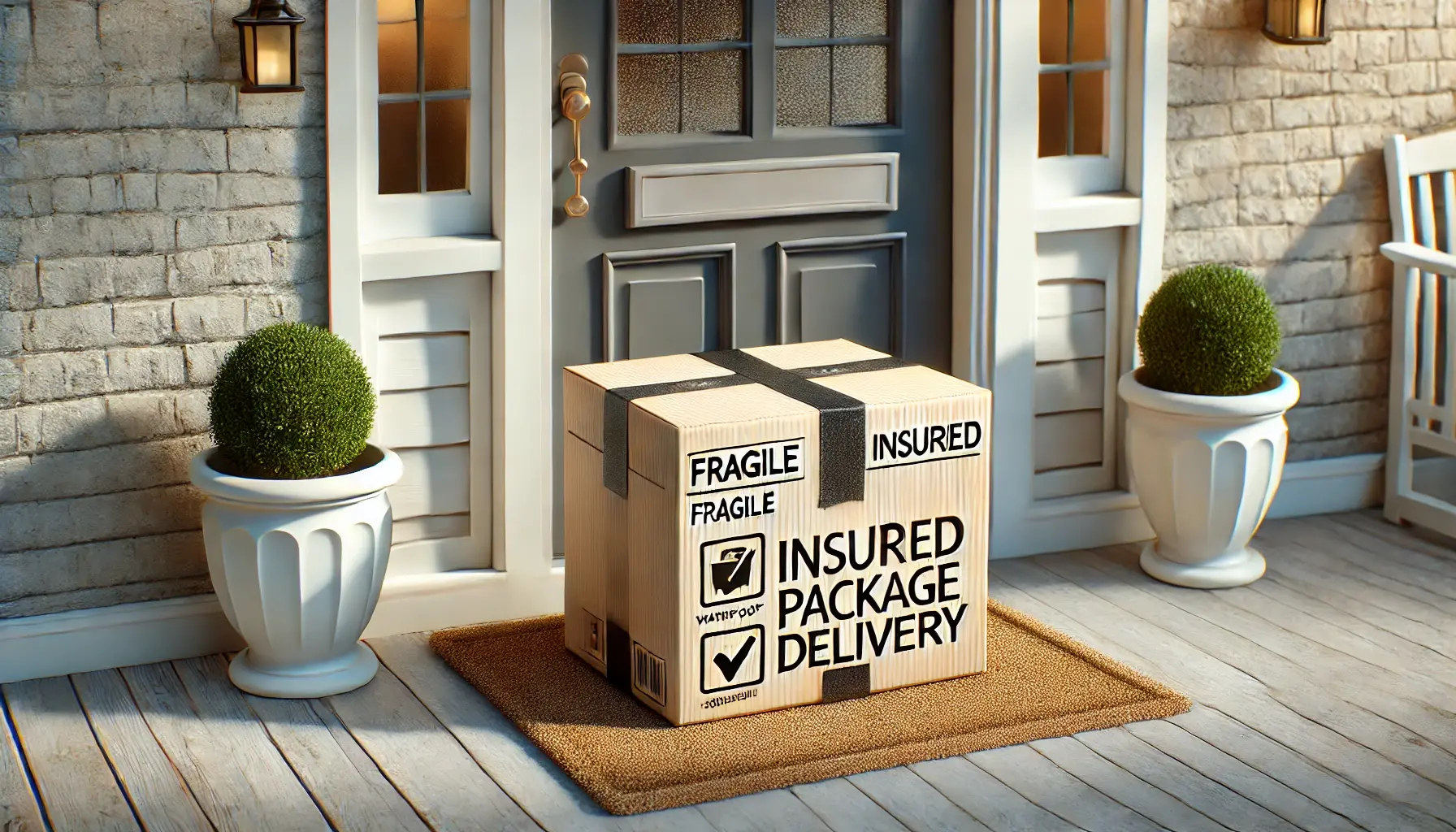

For the latest on ecommerce tips and best practices.
Ship With Confidence: How To Insure a Package
.png)
When a customer orders a product from your online store, they expect to receive it in a reasonable time frame and in perfect condition. So if their package gets lost in transit, damaged, or stolen from their doorstep, they’re understandably upset.
If the worst-case scenario happens, it’s up to your business to make things right. That’s where shipping insurance comes in! Shipping insurance acts as a safety net to protect your business and customers when delivery doesn’t go as expected.
What Is Shipping Insurance?
Shipping insurance is insurance that provides coverage for issues that arise during the delivery process, including package loss, theft, and damage. If something happens to a package, the shipping insurance covers the costs of the item(s). Depending on the policy, it may cover the shipping cost as well.
Insurance can either be purchased by the seller or the customer, and whoever pays for the insurance is responsible for filing a claim if something goes wrong with a shipment.
All the major shipping carriers offer built-in package protection, but you can also purchase insurance from third-party providers. If you’re a Shopify user, free apps like Norton Shopping Guarantee with Package Protection by EasyPost make it easy and affordable to add shipping insurance to your store.
Why Is Shipping Insurance Important?
Shipping insurance isn’t required—you can run an ecommerce store without it. However, many businesses choose to invest in insurance because it provides peace of mind, a competitive edge, and greater financial security.
- Increased peace of mind. With insurance, customers feel reassured about the safety of their orders, and you don’t have to worry about reimbursing people for lost, damaged, or stolen packages.
- A competitive edge. People tend to buy from stores when they feel confident their purchase will be protected; in fact, (47%) of shoppers say they would prioritize the guarantee that their product arrives safely (or is immediately replaced) over two-day shipping.
- Financial security. While most carriers automatically accept liability for packages worth up to $100, relying on declared value alone is risky. If you can’t prove the carrier was at fault for the shipping issue, you’ll have to pay the costs out of pocket. Declared value agreements also don’t cover porch piracy, though customers often expect you to replace stolen packages. Insurance provides the greatest financial security because it covers every scenario and protects high-value packages.
- Better customer service. Having insurance helps shipping issues get resolved more quickly, creating a better consumer experience.
Who Pays for Shipping Insurance?
While the major carriers offer a small amount of built-in package coverage, adding extra insurance costs more. So who fronts the bill?
Shipping insurance can either be paid for by the business or the customer. If your business decides to take on the insurance cost, you’ll pay the premium for each product shipped and take care of submitting claims. You might decide to raise prices to account for the insurance cost.
Alternatively, you can give customers the option to purchase insurance during checkout. If they choose to add buyer’s insurance, they pay for it themselves and get in touch with the provider directly to resolve issues.
How Does Shipping Insurance Work?
Wondering how to insure a package? After selecting the type of insurance you want, you can automatically add it to packages or give customers the option to purchase their own package protection. Let’s run through the steps to get set up.
Choose the Type of Insurance You Want
First, decide whether to purchase insurance or give buyers the option to add insurance at checkout. Next, decide where you’ll purchase insurance from. If you decide to offer insurance as a seller, you might take advantage of a carrier’s insurance offering or declared value service. If you use shipping software like EasyPost, you can purchase insurance through the platform, automatically adding it to packages. If buyer’s insurance sounds like a better fit for your business, consider using a Shopify plugin like Norton Shopping Guarantee with Package Protection by EasyPost.
As you explore insurance options, make sure to read and understand each policy’s terms and conditions. Does the policy protect against damage, loss, or theft? Are there any coverage limitations? Note that some types of insurance exclude high-value items such as jewelry; to insure those, you may need to choose a specialized provider and policy.
Add Insurance Automatically or Allow Buyers To Select at Checkout
Once you’ve signed an agreement with an insurance provider, you can begin offering insurance to your customers. Either add it automatically to packages or make it optional, letting customers choose to pay an additional fee for package protection.
Track the Shipment
Once an order is shipped, you and the customer can track the shipment. Real-time package tracking provides data that will come in handy if any issues arise. If the package gets lost or damaged, and you need to file a claim, the carrier may review the tracking data to recover the package or learn what went wrong.
Submit a Claim
Ideally, shipments will go off without a hitch. But let’s say something goes awry—what then? Depending on the insurance arrangement, either your company or the customer will submit a claim to the insurance provider. This usually involves providing evidence of the incident, such as a tracking number, photos of damaged items, or proof of shipment.
Claim Is Resolved
The insurance provider reviews the claim and, if approved, provides compensation to you or your customer. This involves reimbursement for the value of the lost or damaged items, up to the coverage limit specified in the insurance policy.
What Does Shipping Insurance Cover?
Shipping insurance often covers items that are lost, stolen, or damaged. The insurance pays for the worth of the product, and it may also cover the cost of shipping. Some policies exclude certain high-value items.
How Much Does Shipping Insurance Cost?
Because shipping insurance is based on the value of the shipment, the total cost can vary. Generally, rates are between 1% and 3% percent of the declared value. For example, if the shipping insurance rate is 3% percent, and an item is worth $100, the insurance cost is $3.00. There are usually coverage minimums and limits as well.
UPS Shipping Coverage
Without a declared package value, UPS’s liability is limited to $100 per package. Declaring a higher value will protect the package if it’s lost or damaged by UPS, but it won’t offer protection against porch piracy. To declare a shipment’s value up to $50,000, you’ll need to pay an additional fee.
The table below lists the declared value fees as of January 2024. You can find more details in the 2024 UPS Rate & Service Guide.
|
Declared value |
Charge |
|
$0.00-$100 |
No charge |
|
$100.01 to $300.00 |
$4.35 |
|
Over $300.00 |
$1.45 per each $100 of value declared |
You can also add additional shipping insurance to your UPS shipment through their InsureShield service. This service “protect[s] in-transit shipments and warehoused goods against loss, damage and porch piracy with higher coverage limits than non-insurance.
USPS Shipping Coverage
Priority Mail Express®, Priority Mail®, and USPS Ground Advantage™ services include up to $100 worth of package protection in the shipping cost. This covers loss, damage, or missing items. You can also purchase up to $5,000 worth of insurance for an extra fee (see full details here).
|
Declared value |
Charge |
|
$0.01 - $50.00 |
$2.70 |
|
50.01 - 100.00 |
3.45 |
|
100.01 - 200.00 |
4.55 |
|
200.01 - 300.00 |
5.95 |
|
300.01 - 400.00 |
7.50 |
|
400.01 - 500.00 |
9.05 |
|
500.01 - 600.00 |
12.15 |
|
600.01 - 5,000.00 |
$12.15 plus $1.85 per $100.00 over $600 in declared value |
FedEx Shipping Coverage
FedEx doesn’t offer an option to purchase insurance (they recommend buying insurance through a third party if you want to go that route), but they do allow you to declare your package’s value. The fee structure for U.S. Express Package Services and U.S. Ground Services is simple.
|
Declared value |
Charge |
|
$100.01–$300 |
$4.20 |
|
Over $300 |
$1.40 per $100 of declared value |
These numbers are up-to-date as of January 2024.
FedEx sets a maximum declared value of $50,000 for most service types, with some valuable items (such as artwork or jewelry) having a maximum declared value of $1,000.
How To File a Shipping Insurance Claim
When a package gets lost, stolen, or damaged, it’s essential to file a claim as soon as possible. As a basic rule, you should gather as much evidence as you can about the situation. Provide the carrier with proof that the package left your distribution center in good condition, and show them any other shipping documents.
Let’s take a closer look at each carrier’s claims filing process.
With UPS
To file a claim with UPS, follow these steps:
- Provide information about the package, including the tracking number, weight, and recipient’s contact information.
- Let UPS know you’re the appointed representative of the shipper.
- Support your claim with additional documentation, such as receipts, invoices, purchase orders, and photos of damaged packages.
- Submit your claim and check the progress on your dashboard.
With USPS
To file a claim with USPS, follow these steps:
- Check the filing period, which depends on the service, mailing date, and whether the package arrived damaged.
- Gather the appropriate documentation, including the tracking or label number, evidence of insurance, proof of value (receipt, invoice, etc.), and proof of damage.
- File your claim online, keeping the evidence until the claim has been resolved.
With FedEx
To file a claim with FedEx, follow these steps:
- Begin a claim using the online claim form (you’ll need your tracking number).
- Add supporting documentation, which might include photos of damaged packages, proof of value, and a receipt or invoice.
- Submit the claim form.
- If necessary, schedule an inspection or conduct your own for items worth between $100 and $1,000.
- Track your claim status through the online portal or request email updates.
How To Know if Shipping Insurance Is Worth It
Is shipping insurance right for your business? Investing in package protection is usually a good idea if you ship lots of orders and/or sell high-value items.
- High volume of orders. The more packages you ship, the higher the chances that something will go wrong with a delivery—and you’ll lose time and money trying to resolve issues on your own. Insurance takes this burden off your business.
- Valuable products. Shipping insurance is usually a better deal for high-value products. Think about it—would you rather pay $15 to replace a T-shirt or hundreds of dollars to replace a smartphone? While some expensive products are excluded from insurance policies, you should look into insurance if your products have a high monetary value.
- You want peace of mind. You’ll never be able to predict every logistics disaster your business might face, but shipping insurance takes some of your worries away.
Discover a Simpler Way To Offer Shipping Insurance
In this guide, we’ve covered the basics of how to insure a package. And as you’ve seen, you have lots of things to consider when selecting insurance. If you’re a Shopify merchant, one of the simplest strategies is to install Norton Shopping Guarantee with Package Protection by EasyPost
The plugin is an effective, hassle-free way to begin offering shipping insurance. In addition to giving customers the choice to purchase insurance at checkout, it comes with a shopping guarantee that establishes credibility, boosts conversion, and increases repeat customers.
Install the app for free or chat with one of our ecommerce experts to learn more about how it can benefit your business.
Stay in the know
Subscribe to the Norton Shopping Guarantee blog and receive the latest in ecommerce best practices.

.png)

.png)